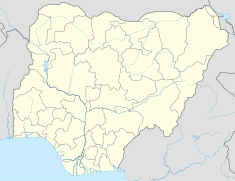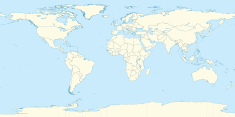
Kainji Dam is a dam across the Niger River in Niger State of Central Nigeria. Construction of the dam was carried out by Impregilo to designs by Joint Consultants, Balfour Beatty and Nedeco, and began in 1964 to be completed in 1968. The total cost was estimated at US$209 million, with one-quarter of this amount used to resettle people displaced by the construction of the dam and its reservoir, Kainji Lake.

Kiira Hydroelectric Power Station, is a hydroelectric power station in Uganda, with an installed capacity of 200 megawatts (270,000 hp).

The Cambambe Hydroelectric Power Station is a hydroelectric power plant across the Kwanza River at the border between Cuanza Norte Province and Bengo Province in Angola. Following rehabilitation and expansion, the generation capacity of this installation is 960 megawatts (1,290,000 hp).
The Ruacana Hydroelectric Power Station is a hydroelectric power plant near Ruacana in northwest Namibia, close to the Angolan border. Commissioned in 1978, it is by far the largest power station in Namibia. Its operator is NamPower, the Namibian national electric power utility company.
The Karuma Hydroelectric Power Station is a 600 MW hydroelectric power project under construction in Uganda. When completed, it will be the largest power-generating installation in the country.
Muvumbe Hydroelectric Power Station is a 6.5 megawatts (8,700 hp) hydroelectric power station in the Western Region of Uganda.

The Lauca Hydroelectric Power Station is a 2,070 MW (2,775,916 hp) hydroelectric power plant, under construction in Angola. Completed in 2020, it is the largest power station in the country.
Ruzizi III Hydroelectric Power Station is a proposed hydropower plant with planned capacity installation of 206 MW when completed.
Achwa 2 Hydroelectric Power Station is a 41 megawatts (55,000 hp) hydroelectric power plant, in Uganda.
Zungeru Hydroelectric Power Station is a 700 megawatts (940,000 hp) hydroelectric power plant under construction in Niger State, Nigeria. When completed, as expected, it will be the second-largest hydroelectric power station in the country, behind the 760 megawatts (1,020,000 hp) Kainji Hydroelectric Power Station.
The Baynes Hydroelectric Power Station is a planned 600 megawatts (804,613 hp) hydroelectric power plant in northwest Namibia, at the border with Angola.
Nzilo Hydroelectric Power Station is an operational hydropower plant in the Democratic Republic of the Congo, with installed capacity of 100 megawatts (130,000 hp). It is operated by the Congolese electricity utility company, Société Nationale d'Électricité (SNEL).
The Matala Power Station is a hydroelectric power station across the Kunene River, in Angola, that has installed generation capacity of 40 MW (54,000 hp). The power station came online in 1954.
The Zongo II Power Station, also Zongo 2 Power Station, is a hydroelectric power station across the Inkisi River that harnesses the energy of the Zongo Falls in the Democratic Republic of the Congo. Construction began on 14 March 2012 and concluded in 2018. The power station was officially inaugurated on 22 June 2018 by the President of the DR Congo, at that time, Joseph Kabila.
Bumbuna II Hydroelectric Power Station is a planned 143 megawatts (192,000 hp) hydroelectric power station in Sierra Leone. The power plant is under development by a consortium of renewable energy IPPs and investors, led by Joule Africa Limited. The energy generated here will be sold to Electricity Distribution and Supply Authority (EDSA), the electricity utility company of Sierra Leone, under a 25-year power purchase agreement.
Kabu 16 Hydroelectric Power Station is a 20 megawatts (27,000 hp) hydroelectric power station under construction in Burundi. It is under development by the government of Burundi, with funding from the Exim Bank of India. Construction began in March 2019.
The Kashimbila Hydroelectric Power Station, also Kashimbilla Hydroelectric Power Station is a 40 MW hydroelectric power station across the Katsina River in Nigeria. Originally intended to be an 18 megawatt installation, the dam and power station were re-configured to a 40 MW power station and the dam reservoir expanded from 200Mm3 to 500Mm3. The energy generated here is distributed within Taraba State, helping to meet an estimated 80 percent of households and businesses, as of 2020.
The Mbakaou Power Station is an operational 1.48 megawatts (1,980 hp) mini hydroelectric power station in Cameroon. Commercially commissioned in December 2021, the renewable energy project was jointly developed by the Government of Cameroon, in collaboration with IED Invest, an independent power producer (IPP) based in France, and Eneo Cameroon S.A., the Cameroonian national electric distribution parastatal company. The power generated at this power plant, amounting to 11.2 GWh annually, is sold to Eneo Cameroon, under a 20-year power purchase agreement, and is distributed to an estimated 40,000 people in the Adamawa Province of Cameroon.
The Gurara II Power Station is a proposed 360 megawatts hydroelectric power station across the Gurara River in Nigeria. The power station is owned and is under development by the Federal Government of Nigeria. The Exim Bank of China has agreed to lend US$1 billion towards the construction of this renewable energy project. The Nigerian Federal Executive Council accepted that offer in May 2019.







